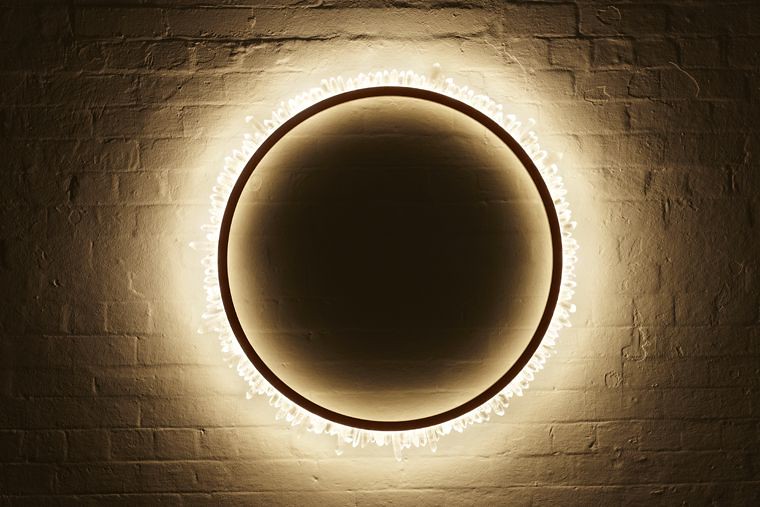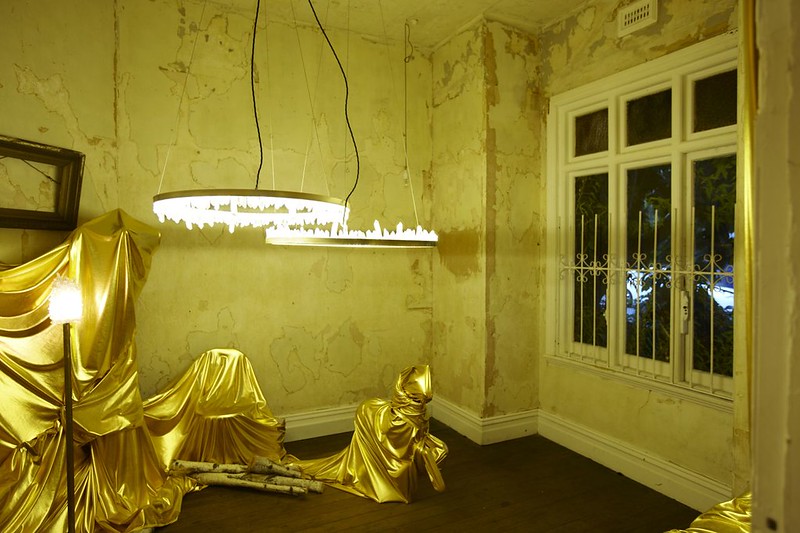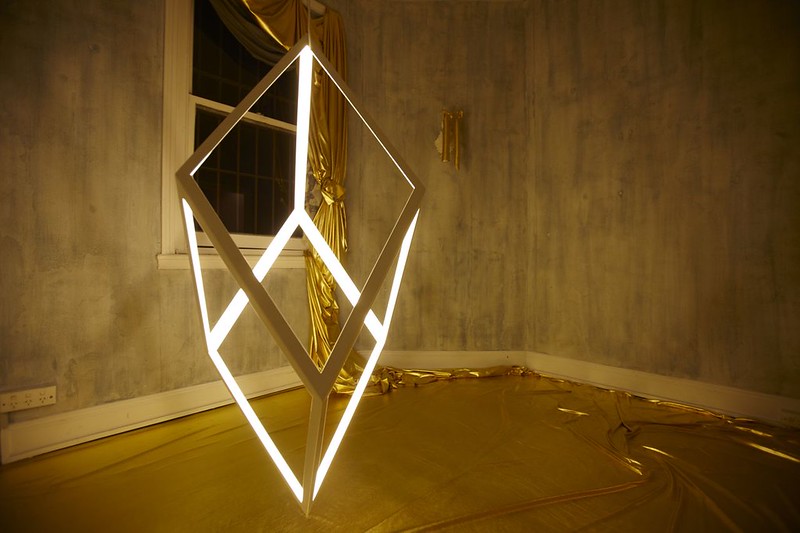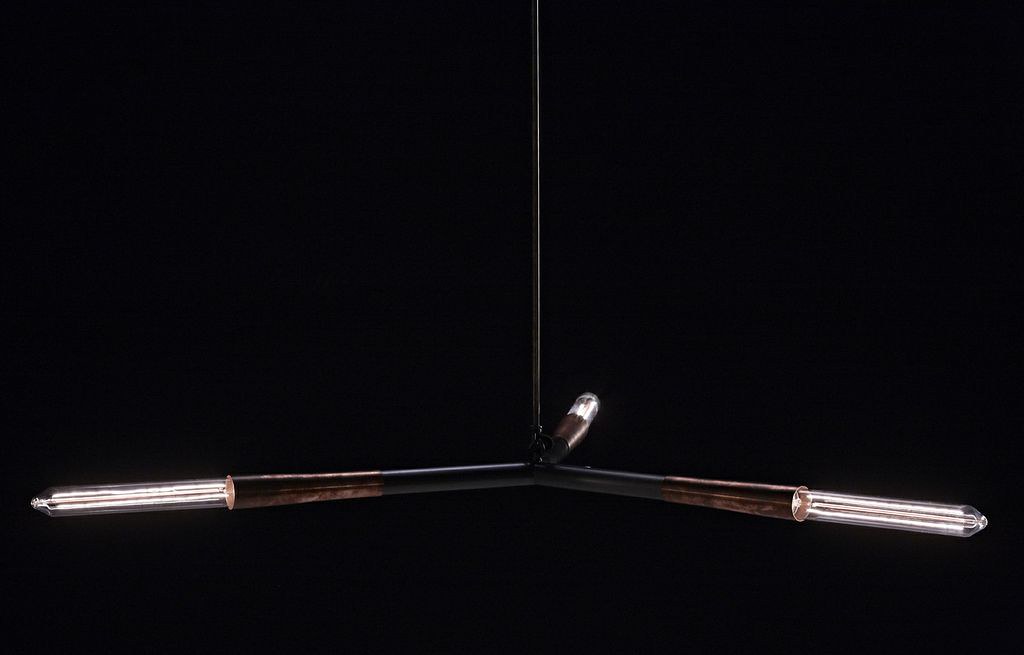had I not taken the designer path.
In fact I'll probably do all of these one day, once I make the time."


The diamond ring (materials: quartz crystal, neodymium rare, earth magnets, iron, carbon), where did the idea come from? What is your attraction to crystals? I have always loved crystals since I was a kid. I found my first one on a beach when I was 8 years old. I've still got a little guide book on rocks and minerals that sparked my imagination about Geology. I was all about rocks as I grew up and was certainly alone in my own world. I always wanted to create an object that would have the power and awesomeness that I imagined always existed in that dream space land I daydreamed about. I guess the current work is the culmination of my life thus far. Geeky kid into rocks + design experience and training = diamond ring:) People occasionally ask about the energetic properties of crystals, magnets and light being all placed together and powered up. I guess that the result speaks for itself- a glowing manifestation of the unique crystalline structures of earth's minerals. Quartz crystals have been used for eons in many cultures for reasons that they are as unique as the people that use them. Essentially, they retain any information that is programmed into them energetically. The intention the studio has when using quartz crystal in lighting is to facilitate the expansion of consciousness in these times, we are now at the end of one calendar and moving into a new paradigm. Changing the world one interior at a time ;) What are rare earth magnets? Rare earth magnets are classified as rare since they use minerals such as neodymium that keep their magnetism permanently. They are adhered to the crystals, and thus magnetized to the frames made from steel (iron+carbon) very strongly, allowing them to be re-arranged and removed for cleaning (perhaps cleansing out in the full moon as required if that's your thing) and aesthetic purposes. This kind of interaction engages and personalizes the product experience. How do you design? Daydream often. Sometimes the best work I sketch while waiting in a plane during taxi. Love that time as there's no digital distractions. Seriously the best time ever- you're in-between spaces and can go anywhere. I reflect on what I've seen and where I'm going. Think, lots. first. The brain will always be superior to any computer- gospel from my grandma! Sketch very rough concepts. Run straight with making by hand at full size with the actual materials. This gets expensive but it's worth every cent. Full size model making is good also but the materiality is second to none, to feel the material and know it, to guide it and work with it- to understand the full capabilities of the materials you work with is critical to be able to make them perform to the best capacity that they can. How long have you been out on your own as a lighting designer? What were you doing before working on your own? After high school I did a B.A. in Linguistics and Cinema, thinking I could change the world through the means of media. However theory became extremely tiresome and I pined for being practical. I studied Industrial Design at Swinburne National School of Design from 2000-2004. I'd always been making chairs, tables, lights and sculptures as I was growing up so industrial design was a natural extension of those explorations into built form. I was very close to transferring into Architecture but decided to complete studies and save another few institutional years. I graduated in 2005 and pretty much worked with a lighting designer, Geoffrey Mance, straight away the first day I was in his studio. I worked there for two years, and for the last six months until his untimely passing away from cancer in early 2007, I was managing the studio. He asked myself and a colleague if we wanted to carry on the business and we said yes. Little did I know how much work was ahead for the next few years. We built up the studio from 3 to 12 people, but were still running with old designs. I pretty much had enough of that studio by 2010 and sold out my share by 2011, and spent the year chilling out, doing yoga, drinking tea, traveling and designing a new collection that you see today. I never looked back. If anyone can take a year off from work, do it every few years, I highly recommend a sabbatical every now and again!

What makes a light interesting? Thats a good question! And very open to interpretation. Personally, it needs to speak to me in a language that is not cut and paste, that has an effect that is gentle to the eye (think ambiance and the effect on the face and perception of the space) and allows one to ponder how it all came together, without being too busy or fussy. And it has to be easy to clean and maintain. Longevity is critical in a product, it must look as good or better in 10 or 20 years time as it does today. Materials you are interested in working with, or are currently working with? Bronze- love it- amazing textures can be created by hand in the wax molds, beautiful colors, warmth and timeless classicism. Quartz- forever amazing, a manifestation of pure earth energy, clear as ice and each and every one has its own character and individuality, just like people all the same yet different. Gold - never tarnishes, always keeps its sheen, is antimicrobial (crazy huh!) and in small quantities is never ostentatious. I like to use it in interior surfaces where only a glimpse may be had- so as to create a surprise. What is the design culture like in Victoria? Pretty strong. Melbourne is the cultural hub of Australia. There's a plurality of designers and architects who view design as a process and spend time overseas in places like Berlin and New York for many years to stretch their wings before coming home, if at all. It's still a small town to me even though the population is about 4 million. Lots of tea towels and cupcakes with birds on them too.. There's activity on many levels from small boutique lane and carpark design markets to a healthy home building and renovation boom (which we are the tail end of now after a decade) which still presents many opportunites for product and service offerings for the a&d community. Architects, writers, or designers of the present or past that resonate with you? I'd have to say that Frank Lloyd Wright, Zaha Hadid, James Turrell, Olafur Eliasson, Stanley Kubrick, Alexander Mcqueen and Tom Ford are among those in my library of awesome people whose body of work I respect and admire greatly. 3 things you can tell me that i would never think to ask? I would have been an arborist, stuntman or Shiatsu practitioner had I not taken the designer path. In fact I'll probably do all of these one day, once I make the time.


What is your attraction to copper? Copper is a beautiful, warm and ductile material. I find that it has an archetypal quality to its warmth and ambience. It ages gracefully and patinates well over time. In the studio environment we can make the copper take color from a warm chocolate to a dark bronze through to a soft green, it has so many lives that it can become. and can be polished up to a high sheen again. it's so versatile and for me, classic. I have 24 hours in Victoria, where are you taking me? Depends what you're into.. My kind of journey would include breakfast in a laneway like Degraves St, followed by an architecture tour of fine examples of historical and recent architecture located in the cbd (rmit, exhibition buildings in carlton, manchester united building, federation square, melbourne recital centre, acca to name a few) and surrounding suburbs, followed by a quick trip down the coast to the great ocean road for spectacular ocean scenery, and back in again for drinks and dinner in fitzroy or collingwood.
Christopher Boots is driven by a love of nature and light, expressed through designing and creating beautiful, unique lighting. Trained in Industrial Design, Christopher Boots has a background in product design engineering. Boots began his own Architectural Lighting Design practice in early 2011 after half a decade at the stewardship of Mance Design. Moving upwards with a completely new and unparalleled lighting collection has driven Boots to seek a commitment to nothing short of excellence. All products are hand made in Melbourne, Australia using a broad variety of techniques from a team of artisans, such as glass-blowers, coppersmiths, ceramicists, sculptors, and bronze casters, ensuring a commitment to quality. The studio carefully composes these artisans as an orchestra for perfect harmony.
